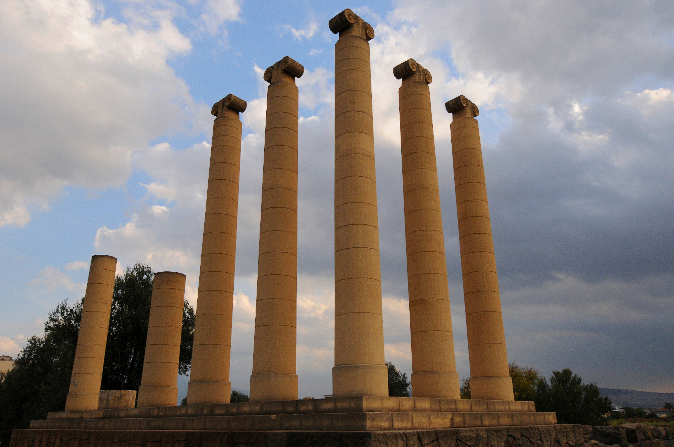
Ancient İzmir (Smyrna) was built on a small peninsula with a size of approximately hundred decare, which was located on the northeast of the İzmir gulf. During the last centruies, with the soil coming with floods from the Meles River through Sipvlos (Yamanlar) Mountain, today’s Bornova plain was formed and the small peninsula turned into a hill. Now known as “Tepekule”, over this mound visitors can see a wineyard.
Although the first settlements in İzmir reach far earlier than 3000 BC, the recent excavations show only 3000 BC yet. According to the information gained by these excavations, the first settlers of İzmir were building their homes on the top level of the mound 3 to 5 meters above sea level. This first settlement belongs to Bronze Age.
During the Iron Age, houses in İzmir were made of one room buildings in different sizes. The oldest house unearthed was dated to 925 BC – 900 BC. In this one room house (2,45 x 4 m.), which was found well preserved, the walls were made of mudbrick, and the roof was made of reeds. Ancient İzmir community started to protect their city with a thick wall made of mudbrick. It can be said that the Ancient İzmir became a city state after this time. It is presumed that the city was under the command of a ruler called “Basileus”. The migrating settlers and prominent people of the city were constituting the noble class. Population living in city walls was probably around one thousand. In the period, which is marked as Late Geometric and Subgeometric ceramics (750 BC – 650 BC), the population of the peninsula was more crowded, possibly exceeding 1500 people. Most of the population belonging to city state were living in the nearby villages. In these villages, agricultural fields, olive trees, wineyards, pottery and stoneware workshops were to be found. Means for living were agriculture and fishing. The most significant divine building of the city was the Athena Temple. The oldest ruin of this building preserved until today is dated to 725-700 BC. The golden era of Ancient İzmir was lived in the years of 650 BC – 545 BC. Lasting almost hundred years, this period was the strongest time of the whole Ionian civilization.
During this period we see that İzmir didn’t confine itself to farming only, also became a part of Mediterranean trade. One of the important signs of Golden Era in İzmir is the fact that writing becomes more prevalent after 650 BC. Many gifts offered to goddess Athena include presentation notes. Maybe not many, but some of the city folk were literate. Temple of Athena (640 BC – 580 BC), which was unearthed with the excavations, is the oldest architectural work of Eastern Hellenic world. The oldest and most beautiful column capitals are found in İzmir until now. The avenues and streets of Ancient İzmir had already in the second half of 7th century grid plan, these avenues and streets were lining along from north to south and from east to west; houses were usually looking at southern side. This city plan, which would be named as “Hippodamos type” in 5th century BC, was in fact long known in Near East. Bayraklı (Ancient İzmir) city plan is the oldest example of this type of city architecture in Western World. The oldest parquet floored way of Ionian civilization is unearthed in İzmir. The oldest example of civil architecture of Hellenic world is the beautiful stone fountain made in Ancient İzmir in the first half of 7th century BC. The Tantalus tomb, once raised up on Yamanlar Mountain, is representing a beautiful example of tholos shaped monumental tombs. The tomb room of Tantalus tumulus was present in the plan of the above mentioned fountain and like the fountain, it had the Isopata structure type, that means its plan was tetragonal and was covered with an imbricated vault. This monumental work, known as the “Tantalus tomb”, must be the tomb of the basileus or the tyrant, who ruled in Ancient İzmir between 580-520 BC.
The wealth and advancement of İzmir as a city began to attract the attention of neighbouring Lydians and they started war with İzmir. Around 610-600 BC the Lydians took over the city, later they destroyed the city, but the İzmir residents succeeded in rebuilding their city. The fall of Ancient İzmir is a result of Persian invasion in Anatolia. While advancing in Anatolia, Persian armies asked for the support of Aegean cities against the Lydian Kingdom. In order to punish the Aegean cities for not complying with this wish, they first took over Lydian capital Sardes, then they attacked the Aegean cities including İzmir. In 545 BC, İzmir was burned and destroyed. After this destruction there was never any kind of settlement in the form of a city again in Bayraklı region.